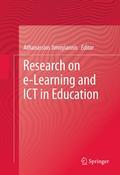
This book aims to serve as a multidisciplinary forum covering technical, pedagogical, organizational, instructional, as well as policy aspects of ICT in Education and e-Learning. Special emphasis is given to applied research relevantto educational practice guided by the educational realities in schools, colleges, universities and informal learning organizations. In a more generic scope, the volume aims to encompass current trends and issues determining ICT integration in practice, including learning and teaching, curriculum and instructional design, learning media and environments, teacher education and professional development, assessment and evaluation, etc. Up to date information on all aspects ICT and e-learning. Includes the latest on innovative instructional design and pedagogy for e-learning. Concrete examples for providing ICT-enhanced instruction to learners of all ages. The latest advances in wireless, mobile, and virtual learning environments are provided. Utilization of the gaming environment in ICT and e-learning is explainedin detail. INDICE: -1. School 2.0: rethinking the future of schools in the digital age. -2. MirandaMods: from practice to praxis in informal professional learning contexts. -3. Synthetic worlds and virtual citizens: Experimental ethnographicsimulation, virtual autotopography and emerging citizenship identity in youngpeople. - 4.Teaching in the Knowledge Society: between technology and competences. - 5. Digital divide, students’ use of the Internet and emerging forms ofsocial inequalities. - 6. Supporting teachers in orchestrating CSCL classrooms. - 7. Reorienting teacher education to address sustainable development through WikiQuESD. - 8. Can ICT reduce drop-out rates among new teachers? A qualitative study in Canadian student teachers. -9. Examining the use of text corporaand online dictionaries as learning tools: Pre-service teachers' perspectives. - 10. The Cypriot public primary school principals’ self-perceived competence and use of ICT for personal, teaching and administrative purposes. - 11. Instructional design on controlling the quality of collaboration in a CSCL setting through illusionary adaptive support. - 12.The design and development of a wiki task in undergraduate education: Retrospects and prospects. - 13.Educational blogging: Developing and investigating a students’ community of inquiry. - 14.Experiencing 3d simulated space through different perspectives. - 15.Educational robotics and teaching introductory programming within an interdisciplinary framework. - 16.Teaching electric circuits by guided inquiry in virtual andreal laboratory environments. - 17.Games-based learning and Web 2.0 technologies in education: Motivating the 'i-Learner' generation. - 18.Presence in a collaborative science learning activity in Second Life. -19. Emotional interaction in e-Learning. - 20. Virtual models of conic sections. -21. Towards community-based open educational resources: Tools for developing and managing IEEE LOM application profiles. - 22.Restrictions and abilities of SCORM: a path to adaptive course development.
- ISBN: 978-1-4614-1082-9
- Editorial: Springer New York
- Encuadernacion: Cartoné
- Páginas: 359
- Fecha Publicación: 28/10/2011
- Nº Volúmenes: 1
- Idioma: Inglés
